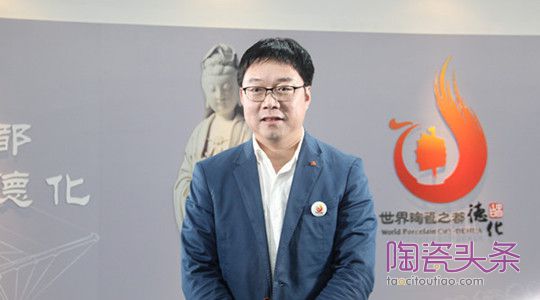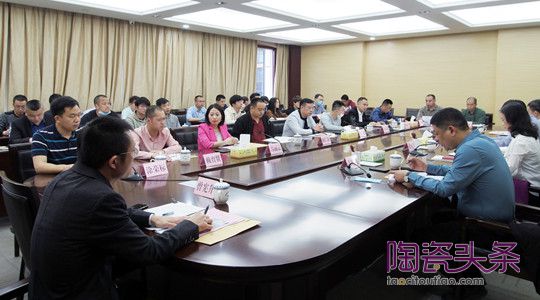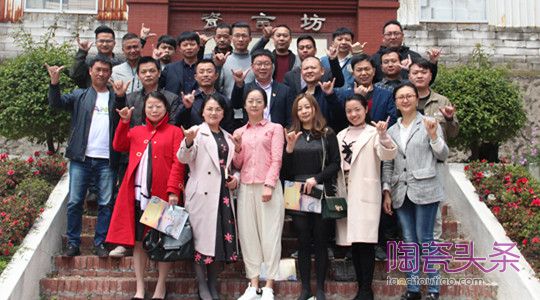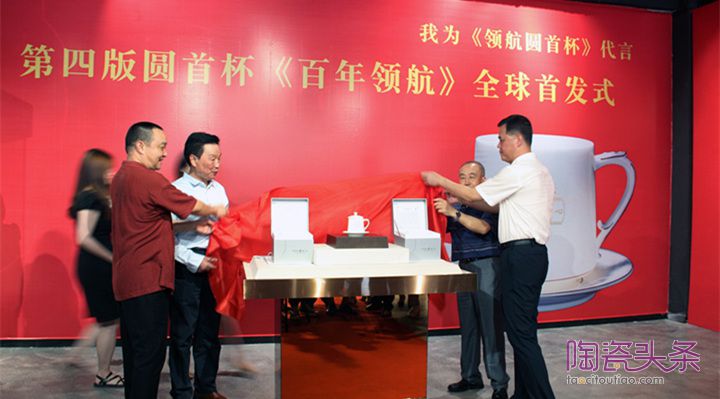外國人眼中的“中國白”4(連載)

-
小陶陶
2021-07-02 15:33:09 1498
10400
編者按:由柯玫瑰(Rose Kerr)、約翰?蓋爾(John Ayers)所著《——德化白瓷》(Blanc de Chine—porcelain from Dehua)于2002年經新加坡亞洲文明博物館出版,是繼唐納利《——福建德化瓷》之后的一本專門研究德化白瓷的專著,影響甚為深遠。
該書收錄的都為國外研究德化白瓷的知名學者所撰寫德化白瓷研究資料。包括柯玫瑰的“德化器物款識介紹”,海蒂(Heidi Tan)的“鑒賞家探訪”,約翰?蓋爾的“的影響”,何翠媚(Chuimei Ho)的“考古眼光中的”,郭勒遜(Kenson Kwok)的“德化雕塑結構的一點看法”, 埃娃?施特勒伯(Eva Strober)的“德累斯頓的斯特朗大帝收藏的德化瓷”,以及附錄介紹等七個部分,從不同角度介紹了德化白瓷。與此同時,該書收錄的160件德化窯精品,為Hickley家藏,后捐贈給新加坡亞洲文明博物館,是了解、品鑒、研究德化白瓷不可多得的藝術精品。
本欄目將定期精選出相關代表性文章進行翻譯,以饗讀者。然而,由于作者水平的局限,翻譯過程中難免有所錯漏,不足之處敬請各位讀者提出寶貴意見。
Blanc de chine: some reflections by John Ayers 的影響(四)——約翰 蓋爾(翻譯: 孫延燕)
Alongside this Guanyin model may be set Donnelly's next dating marker; an early European engraving representing another Guanyin group which may confidently be e iden tified as a blanc de Chine one(Fig. 17). The print appears in the border of one page of the Chinese section of W and J. Blaeu's Nieuw Atlas, first published in Amsterdam in 1655, however, according to Phillip Allen, who kindly obtained the illustra tion for me, this identical printing in fact comes from the 667 edition. The maps were taken over from a preceding wor rk by the Jesuit father Martin Martini, who is said to have left China in 1651.
在這個觀音模型旁邊可能是唐納利的下一個紀年器物,它是一個早期的歐洲版畫代表了另一個觀音團體,可能自信地被認為是瓷器(圖17)。這張印刷品出現在布勞厄的《新地圖集》中文版的一頁邊上,1655年首次在阿姆斯特丹出版,然而,根據菲利普 ? 艾倫的說法,他幫我弄到了這張插圖,這張完全相同的印刷品實際上來自1667的版本。這些地圖是從耶穌會教士馬丁 ? 馬提尼之前的工作接管過來的,據說他在1651年離開了中國。
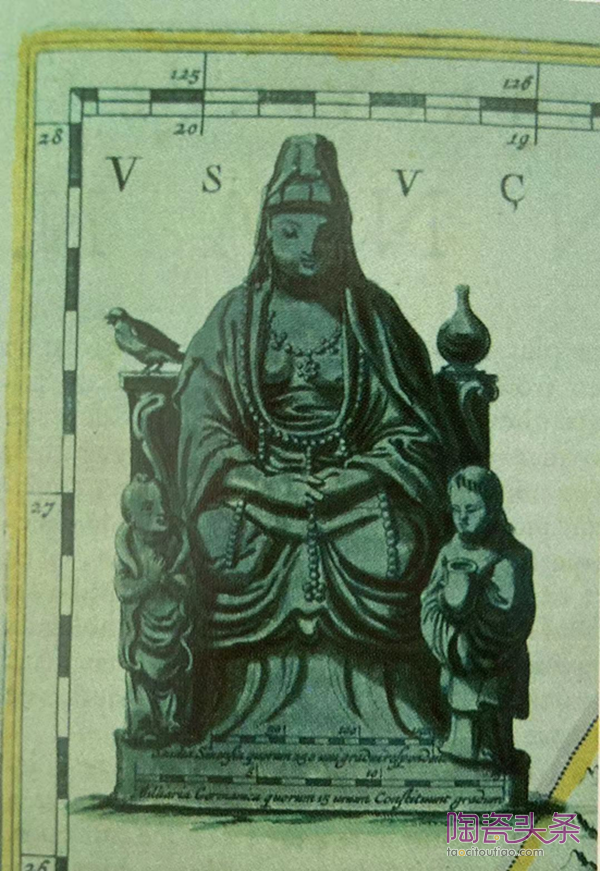
(Figure 17: Guanyin: engraving from Blaeu’s Nieuw Atlas,1655. 圖17: 觀音: 版畫依據布勞厄的《紐約地圖集》,1655年。)
The engraving shows Guanyin seated on a rocky throne and accompanied by her aco- lytes, Shancai and Longnu, below; to left and right are the vase of heavenly dew and a bird. Donnelly was unable to trace any porcelain original corresponding to this, but Phillip Allen has kindly allowed me to show a group now in his possession which is unquestion ably a very close match -and which thus represents a model already existing in 1655, if not indeed before 1651(Fig. 18). Here is the same pose with hands joined on the lap and the same arrangement of the draperies and mantle, the same jewelled pendants, the same base, also the two acolytes, and above these the nectar flask on her right and the bird on the left except that in the engraving process these were reversed On Mr Allen's figures the bird is unfortunately missing, broken off, but curiously enough, very soon after seeing this piece another of our members, Mr Wikramaratna, was fortunate enough to find one in whic the bird was complete, although this time the flask was missing. Once again the deity sits face on to the viewer: it is a form of presentation repeated in many groups In the second half of the century; but a certain stumpiness here fits well with our cencept of the earlier modelling type.
這幅版畫顯示,觀音坐在一個石制的寶座上,旁邊還有她的助手善財和龍女,左右各有一個裝著天露的花瓶和一只鳥。唐納利找不到任何與之相對應的瓷器原件,但菲利普 ? 艾倫熱心的向我展示了一組現在在他手中的瓷器,毫無疑問,它們非常接近,因此代表了一個早在1655年就存在的模型,如果不是在1651年之前的話(圖18)。這是同樣的姿勢,雙手放在膝蓋上,布料和斗篷也是同樣的排列,同樣的珠寶吊墜,同樣的襯衣,還有兩個助手,在這些上面,她右邊的花蜜瓶和左邊的鳥,除了在雕刻過程中,這些在艾倫先生的雕像上倒過來,不幸的是,鳥不見了,斷了,但奇怪的是,在看到這個雕像之后不久,我們的另一位成員,維克拉馬拉特納先生,有幸找到了一個有一只完整的鳥,雖然這一次,這只花蜜瓶不見了。再一次,神坐在面對觀眾: 這是一種表現形式重復在多個群體在后半部分但是這里的某些粗糙與我們早期的造型類型的概念很吻合。

(Figure 18: Guanyin enthroned. 1650. Phillip Allen Collection. 圖18: 加冕的觀音。1650年。菲利普·艾倫收藏。)
For the 1640s and perhaps a little earlier we now have the additional evidence of the Hatcher wreck, which was of course unknown to Donnelly; just a few small figure models were found and these are by no means of fine quality. A small lion on a plinth, forming a taper-holder, exemplifies their characteristics such as the somewhat creamy colour and Blaeu rather heavy treatment of everything (Fig 19): notice also the open-cut, arcade-like base, which before long will be more plainly treated. The finds also include a second variety of somewhat larger lions raised on higher bases: these too are rather crudely worked, and to judge from the photograph the glaze seems to be rather dry. It is worth noting here that Donnelly describes and illustrates another pair of lions in Hong Kong which are actually dated to the year 1645. Another Hatcher wreck model is a small water dropper for the writing-table in the form of a figure in a scholars hat riding on a fish: this is the carp that climbs the rapids, and so provides a popular rebus of success in the official examinations. Originally designed for Chinese use, such items were no doubt brought back from China by Westerners as curios; and these Hatcher pieces may in fact be no more than a sample of what had reached Europe by the mid-seventeenth century.
17世紀40年代,或許更早一點,我們現在有了哈徹號殘骸的額外證據,當然唐納利并不知道,只發現了幾個小人瓷塑,這些絕對不是高質量的。一只小獅子站在基座上,形成一個燭臺,體現了它們的特點,例如乳白色的顏色,以及對一切事物的濃重處理(圖19) : 還要注意露天切割的拱廊式底座,不久這種底座就會得到更清晰的處理。這些發現還包括第二種較大的獅子,它們的底部較高,雕刻也相當粗糙,從照片上看,釉料似乎相當干燥。這里值得一提的是,唐納利描繪了香港的另一對獅子,它們實際上可以追溯到1645年。哈徹號的另一個殘骸瓷塑是一個為書寫做的小水滴,一個人物坐在一條魚的學帽上: 這是鯉魚爬上急流,所以提供了一個在官方考試中魚躍龍門的預言。這些原本是為中國人設計的,毫無疑問是西方人從中國帶回來的古玩,而這些哈徹號瓷器實際上可能不過是17世紀中葉到達歐洲的東西的一個樣本。

(Figure 19: Lion taper-holder, from south China sea.1643. Christie’s. 圖19: 獅子燭臺,來自南中國海1643年。佳士得。)
Figure 20 shows two small figures, one at least of them an exported type, which share in much of this simple, broad treatment. Bodhidharma, the Buddhist patriarch, who appears on the left, is really a rather fine figure both in modelling and in the finishing of the bearded face, as well as in the bold sweep of the robe. The bearded dignitary on the right has the now familiar high-backed throne and an arcaded footstool. Both of these were indicated in the Marchant exhibition where David Freedman was, I think, well justified in dating them in the catalogue to c 1640. Two slightly different versions of the'dignitary one without base, the other with a cruder one -are at Burghley House, where it was inventoried in 1688, and in the Victoria and Albert Museum; perhaps all these were made within a period of twenty years or so.
圖20顯示了兩個小型雕塑,其中至少有一個是出口的,它們分享了大部分這種簡單、寬泛的處理方法。菩提達摩,出現在左邊的佛教元老,在造型和胡子臉的修飾上,以及在長袍的粗線條上,都是一個相當不錯的人物。右邊這位大胡子高官,坐在我們熟悉的高背寶座和拱形腳凳上。這兩個都在馬爾尚展覽中有所提及,我認為,大衛 ? 弗里德曼在1640年的目錄中,很好地證明了它們的年代。兩個稍微不同的版本,一個是沒有基座的高僧,另一個是粗俗的高僧——分別存放在伯利莊園,1688年入庫;和維多利亞和阿爾伯特博物館里,也許所有這些都是在二十年左右的時間里完成的。
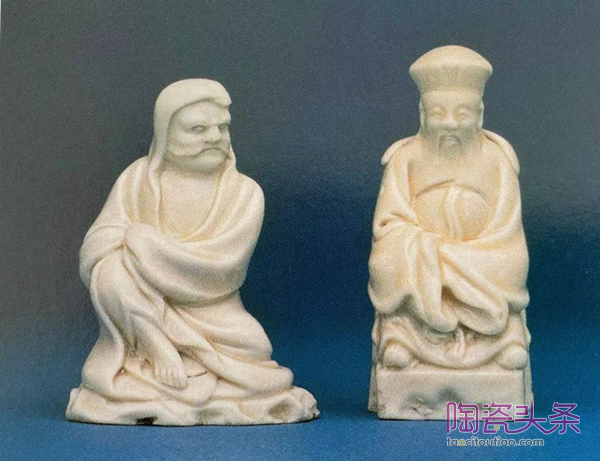
(Figure 20: Left.Bodhidharma. height .6cm. Right. Bearded figure. Height 9.4cm.1620-50. S.Marchant and Son. 圖20: 左側,菩提達摩,身高6厘米。右側,胡須的瓷雕。高9.4厘米,1620-50年。馬錢特和他的兒子。)
The next document for dating figures is a model formerly in the Sneddon collection and shown in an exhibition of blanc de Chine assembled several years ago by Bluett and Sons. Its inscription reads: 'made by Lin Yang with respect and clean-washed hands on a lucky morning in the second spring month of the fifty-eighth cyclical year which in this case can hardly be other than 1681. This is not greatly different in style from the late-seventeenth-century export Guanyin with which I began; and with such pieces it gives some positive clues to the sort of development that had been taking place over the previous thirty or forty years in examples of this quality.Characteristically the figure is rather tall and slender, and Guanyin is represented here standing on a small mound of clouds; the robes are more intricate in their folds than before and are made with sharply cut projections.
下一個關于年代測定的證據是一個瓷塑,以前在斯內登收藏中,而且幾年前在布魯特及其后裔組織的展覽中展出。題字中寫道: “五十八周年第二個春月的一個幸運的早晨,林陽敬重地洗手而作,在這種情況正是1681年。這與我開始的17世紀晚期的外銷觀音的風格沒有很大的不同,通過這些作品,我得到了一些可以看出在過去的三十、四十年間觀音的發展的積極線索。典型的形象是相當高和苗條,觀音在這里站在一團堆積云上;長袍的褶裥比以前更加復雜,而且切割更加突出。
An especially interesting group of figures are those which were not only made for export, but on account of their subjects, can be seen to have been specially commissioned for the West. At Jingdezhen this kind of specialised production was already in progress in the sixteenth century, while the Dutch records from Batavia show that wooden models for forwarding to the factories were supplied at least as early as 1635. It is quite possible there fore that similar instructions were also sent to Dehua; and a significant period for this might well be the years between the fall of the Ming in 1644 and 1662, when the Dutch base in Formosa off the Fujian coast was seized by Coxinga.Catholic Portugal on the other hand, seems a more likely instigator of figures such as the Guanyin-like Madonna and Child in the British Museum-which was perhaps based on a model in ivory produced for example at the settlement of Goa, if not indeed made for the Spanish in Manila. Possibly some models of this kind ought to be dated some decades earlier than the 1680s.
一組特別有趣的人物,不僅是為了出口而制作的,而且因為他們的題材,可以看出是專門為西方制作的。在景德鎮,這種特殊的生產在16世紀就已經開始了,而來自巴達維亞的荷蘭記錄顯示,運往工廠的木制模型至少早在1635年就有了。很有可能在此之前,德化也收到了類似的指示,而這一個重要時期很可能是從1644年明朝滅亡到1662年之間的幾年,當時荷蘭在福建沿海的臺灣基地被科辛加占領。另一方面,信奉天主教的葡萄牙似乎更像是大英博物館中類似觀音的與孩子的圣母的發起者——它可能是基于一個象牙制品的模型,例如在果阿定居點生產的象牙,如果不是真正為其制作的話是馬尼拉的西班牙人。可能有些這種模型的年代,應該比17世紀80年代早幾十年。
I have not yet mentioned the finest figures of all those on which the special fame of the Dehua model. lers is ultimately based. So far as we know, such things did not reach the west at all until the period when they had alrea eady become antique, and the best of our late.Ming group -the Caishen of 1610 and so on-are presumably also in this category. The le finer figures are invariably dated Ming in Chinese circles and while this view has been consistently doubted here in the past, we may now begin to see rather more truth in it.
我還沒有提到最終給德化瓷塑帶來特殊聲譽的那些精美瓷塑。據我們所知,這些東西直到它們已經成為古董的時候才到達西方;而最好的晚明瓷塑,是1610年的財神及其它,大概也屬于這一類。在中國人的文化里,好的瓷塑總是被認為是明代的,雖然這種觀點在過去一直受到質疑,但是我們現在可能開始看到更多的真相。
The subject is a vast one, but let us look briefly at one or two models that bear the most famous of all Dehua potters ma rks: that of He Chaozong. History does not record who, or what, He Chaozong was, al- though Donnelly observes that the mark is found on at least two hundred figures, and in many forms. We need not believe in all of these and no doubt a fair number are versions of a later period. Donnelly's suggested date for He Chaozong's activity is the period between 1665 and 1695, one of thirty years or so, but-if indeed he is to be considered as a single master modeller-this now seems improbably late.
這是一個龐大的主題,但讓我們簡單地看一下一兩個最為有名,帶有德化瓷塑家何朝宗標志的瓷塑。歷史沒有記載何朝宗是誰,盡管唐納利注意到,至少有200個瓷塑身上有這個標記,而且有多種形式。我們不需要相信所有這些,毫無疑問,有相當數量的是后期版本。唐納利建議何朝宗活動的時間是1665年至1695年,大約30年左右,但是——如果他真的被認為是唯一的瓷塑大師——這現在看來似乎有些不可思議。
The model in Figure 21 represents Wenchang, the Star God and patron of literary men; standing some 15 inches high, it is a model of impressive dignity and power, and perhaps the finest of all those shown in Marchant's exhibition. The high, rocky throne is already familiar and so is the subject: we have seen him in a smaller, early seventeenth-century group. This does not, of course, date the model but here other features such as the weight potting and rich, ivory-cream material and glaze are significant. The modelling has bo the proportions a little plump if not so pronouncedly so as in the earlier dated pieces, the folds of the robes natural and without exaggeration, the head and hands not overworked. A date more of the early to mid-century seems appropriate and Marchant's c1640 appears not unreasonable.
圖21中的代表文昌帝君,天神和文人守護神; 站立約15英寸高,是一個令人印象深刻的尊嚴和力量的瓷塑,也許是所有在馬爾尚的展覽中展示的最好的模型。高聳的巖石王座已經為人們所熟知,主題也是如此: 我們曾在17世紀早期的一個較小的群體中見過他。當然,這并不能確定瓷塑的年代,但是這里的其他特征,例如陶土的重量和豐富的象牙奶油材料和釉料都是重要的。瓷塑有一定的寬度和簡潔性,身材比較豐滿,雖然不像早期的作品那么顯眼,袍子的褶皺自然,沒有夸張,頭部和手部也沒有過分累贅。斷代在本世紀早期到中期更合適,而馬錢特的1640年看起來也不是不合理。
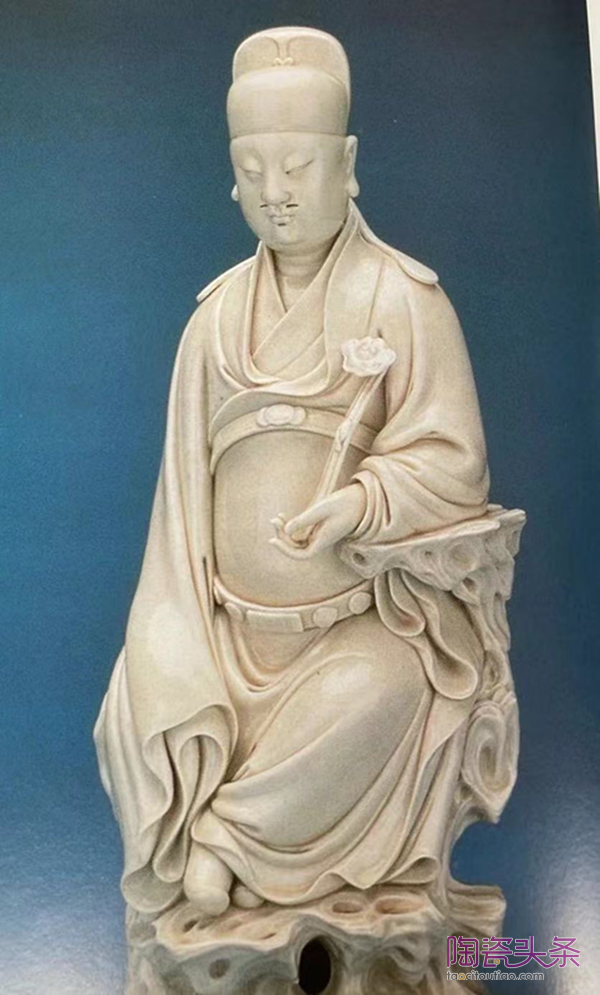
(Figure 21: Wenchang enthroned. Height 38.8 cm. Marker of He Chaozong, c 1620-50 Koger Collection. 圖21: 加冕的文昌帝君,高度38.8厘米。何朝宗,1620-50年,克羅格收藏。)
Fingures such as these are greatly distanced from those in the export class by their sheer quality as sculpture: a distinction that resides in their artistic conception as much as in their quality execution. The models were, however, designed to undergo a great deal of subsequent handwork including not just the removal of mould -ines but a sharpening-up and fining of everything -facial features,hands, and the lines of the robes, which are often substantially undercut; the result stands on an altogether different plane of achievement.
像這樣的瓷塑與之前出口類別的瓷塑就單純質量而言有很大不同: 區別在于它們的藝術構思和質量。然而,這些瓷塑被設計用來進行大量的后續手工制作,不僅包括去除模線,還包括對所有東西——面部特征、手和長袍的線條——進行銳化和精雕細琢,這些線條經常被大幅削弱,其結果是所成就的作品完全不同。
來源:德化陶瓷文化研究院、陶瓷辦
責任編輯:陳美珠




